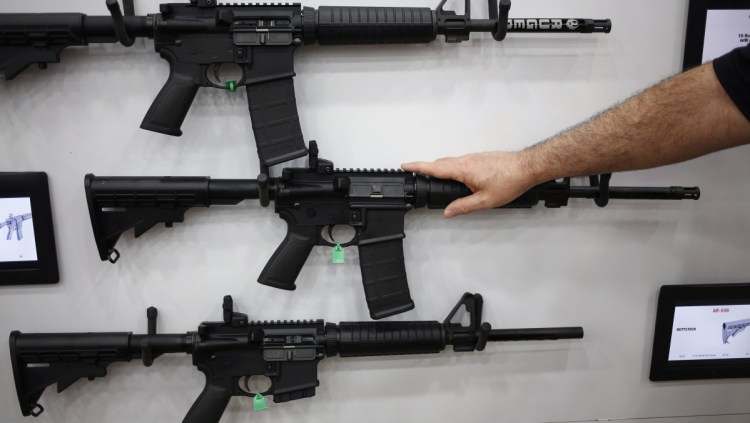The AR-15, the semi-automatic rifle used in Parkland, Florida, in the deadliest high school shooting in U.S. history, uses bullets that can cause softball-size exit wounds, leaving behind a significantly larger trail of mangled tissue compared with handgun bullets.
For trauma surgeons, the injuries are harder to repair. For victims, the chances of survival are lower.
“We’re surgeons, we’re not gods,” said Dr. Nicholas Namias, the director of Ryder Trauma Center at Jackson Memorial Hospital in Miami, which treats about 400 serious gunshot injuries every year. “If you have an injury from a bullet going through an artery at a low velocity, you repair it and go on your way. If you have a high velocity bullet, now you have a huge cavity. Imagine a cavity the size of your fist where everything that should have been there no longer is. How do you fix that?”
The AR-15 and similar rifles fire bullets at a speed of about 2,800 to 3,000 feet per second, compared to a 9-mm handgun, which fires bullets at a speed of between 700 and 1,100 feet per second, said Dr. David Shatz, a trauma surgeon at the University of California, Davis. The difference in speed is what leads to more fatal injuries from people wounded by AR-15s and similar rifles than handguns.
“The bullets hit tissue then fall apart, they tumble and have all these fragments that go all over the place in the tissue,” Shatz said. AR-15 bullets and handgun bullets both tumble through the human body, but the sizes of holes inside the body are vastly different.
WAR VET’S VIEWPOINT
Shatz said bullets cause permanent cavities, where tissue is destroyed, and temporary cavities, which are areas around the permanent cavity that open up for a fraction of a second because of the “sonic force” of a bullet. Cavities caused by bullets like the .223-caliber bullet typically fired by the AR-15 are much larger than the cavities caused by handgun bullets.
Rep. Ruben Gallego, D-Ariz., an Iraq War veteran who trained extensively with the M-16 assault rifle, the military-grade fully automatic version of the AR-15, said the bullets fired by AR-15s are designed to inflict as much damage as possible on human targets.
“The bullet, it travels so fast that it won’t exit cleanly in a line; it will bounce,” Gallego said. In one case, he said, a fellow Marine in Iraq was killed by a bullet from an enemy AK-47 assault rifle that entered just below his armpit, tearing through organs and never leaving the body.
“It disrupts their internal organs,” Gallego said. “In boot camp I was taught this was by design. The military wanted us to shoot somebody and cause so much internal bleeding that it would cost extensive resources from the enemy to keep someone alive. If you think about this round in the hands of civilians and using it in crowded areas, that’s how you get in four minutes 17 people killed.”
9MM NO MATCH
Rep. Brian Mast, R-Fla., who lost his legs while serving as a bomb technician in Afghanistan, said in a New York Times op-ed that he used a rifle similar to the AR-15 while in combat.
The 9 mm handgun he carries to protect himself as a civilian can’t compare in firepower, he said.
“I have fired tens of thousands of rounds through that rifle, many in combat,” Mast wrote. “We used it because it was the most lethal – the best for killing our enemies. I am confident I can eliminate an active shooter who is attacking with a pistol because the attacker would have to be close to me. But the defense my concealed 9 millimeter affords me is largely gone if the attacker is firing from beyond 40 yards, as he could easily do with the AR-15.”
Heather Sher, a Broward County radiologist who treated victims of the Feb. 14 shooting and victims of the 2017 Fort Lauderdale–Hollywood International Airport shooting, where a 9 mm handgun was used, said in a first-person piece in The Atlantic that the AR-15 injuries she witnessed were much worse than the injuries she saw after the airport shooting.
“With an AR-15, the shooter does not have to be particularly accurate,” Sher wrote. “The victim does not have to be unlucky. If a victim takes a direct hit to the liver from an AR-15, the damage is far graver than that of a simple handgun shot injury.”
Copy the Story LinkSend questions/comments to the editors.



Success. Please wait for the page to reload. If the page does not reload within 5 seconds, please refresh the page.
Enter your email and password to access comments.
Hi, to comment on stories you must . This profile is in addition to your subscription and website login.
Already have a commenting profile? .
Invalid username/password.
Please check your email to confirm and complete your registration.
Only subscribers are eligible to post comments. Please subscribe or login first for digital access. Here’s why.
Use the form below to reset your password. When you've submitted your account email, we will send an email with a reset code.